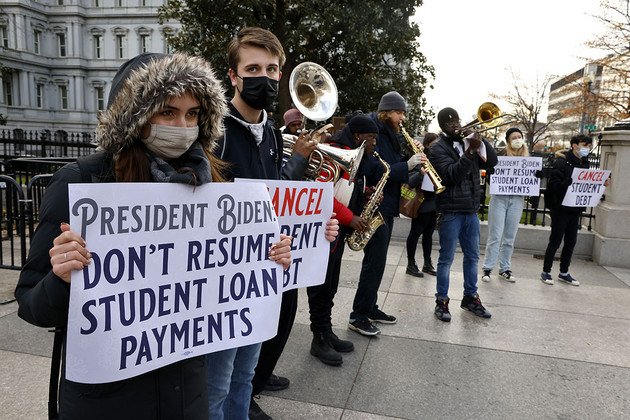Changes to Student Debt Relief Eligibility Leave Millions of Private Borrowers without Relief
Activists in Washington, DC, asking for President Biden to follow through on his campaign promise to cancel federal student loans. Source for image: Paul Morigi, Getty images, via Politico
On September 29th, 2022, the Department of Education quietly changed the eligibility guidelines for the Biden-Harris Administration’s Student Debt Forgiveness action. Under the previous rules, borrowers who took out privately owned federal loans, including FFEL and Perkins loans, had the ability to consolidate their remaining loans through the Direct Loan program in order to receive debt forgiveness; however, on September 29th, the rules pertaining to privately held loans were changed on the Department of Education's website, which now state that private borrowers can no longer consolidate their loans at all and are excluded from any debt relief.
While the FFEL program, which makes up the vast majority of commercially held student loans, ended in 2010, there are still almost 5 million FFEL borrowers making payments. FFEL, or Federal Family Education Loans, are federal backed loans that were previously funded by private companies. After the FFEL program ended, the federal government purchased a portion of the FFEL loans, but many outstanding loans are still commercially held. According to NPR, this change will completely exclude roughly 800,000 borrowers from any debt forgiveness and impact the benefits for another 1.5 million borrowers who have a combination of FFEL and Direct Loans. The Direct Loan program, which replaced the FFEL program, provides low-interest loans directly from the federal government and remains unaffected by these changes. However, borrowers with Perkins Loans will also be affected. While interest payments on Perkins loans are subsidized by the federal government, the loans themselves are commercially held by the borrower's academic institution. This reversal in eligibility comes only a month after the administration first announced their Student Debt Relief Plan on August 24th.
In Biden’s 2020 presidential campaign, he pledged to forgive all undergraduate tuition-related student loan debt for two- and four- year public colleges and private HBCUs and MSIs for borrowers making under $125,000. His campaign pledge reflected the seriousness of the student loan debt crisis. In the United States, more than 44 million Americans owe a combined $1.7 trillion dollars in student loans. Due to rising tuition costs and stagnant wages, reports from the Department of Education estimate that it takes Americans 17 years on average to pay off debt related to their education.
While failing to cancel all undergraduate education related debt, Biden’s new plan makes progress towards alleviating the crisis. Along with up to $20,000 in loan forgiveness, the plan also seeks to reduce the financial burden of those still holding student loans by cutting monthly payments in half, guaranteeing that no one making income below 225% of the federal poverty line will have to make monthly payments, forgiving loan balances of $12,000 or less after 10 years of payments, and covering borrowed unpaid monthly interest. Despite this progress, the Department of Education has left 2.2 million private borrowers with little information and no path forward.
Following the Department of Education’s exclusion of private borrowers, officials have stated that the Department is currently discussing with private lenders whether there are alternative pathways to provide relief for commercially held student loans. While the department has not provided any specific reason for the change, it is likely due to a recent lawsuit filed by six state attorney generals and other potential lawsuits from private lenders that manage FFEL loans. In part of the recent lawsuit filed by the six states, plaintiffs claim that the consolidation of the FFEL loans harms loan servicers by unlawfully depriving them of assets and ongoing interest payments that those loans generate. It is very likely the administration is protecting the recently announced plan by minimizing potential legal action from commercial banks managing student loans. While this action might provide legal cover for the short term, its consequences will come at a great price for the millions of private borrowers suffering the burden of student debt.

